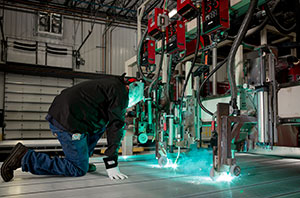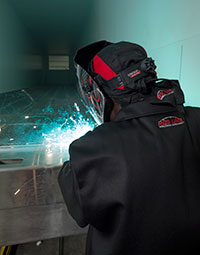Aluminum Welding
In Aluminum Welding, it All Comes Down to Control
The right combination of consumable chemistry, process capabilities and equipment spell success for welding on popular substrate in trailer manufacturing setting
by Frank Armao, Director of Aluminum Technology, The Lincoln Electric Company
Aluminum has become increasingly prevalent in manufacturing as a lightweight alternative to steel, because it delivers an improved strength to weight ratio, corrosion resistance and general, overall weldability. But, as those in the welding industry quickly realize, this material does not behave like steel in welding applications. Far from it.
When it comes to welding performance, aluminum definitely is a different breed. The typical characteristics and performance one expects when welding with steel don’t necessarily apply. This material has high thermal conductivity and a low melting point – factors that can combine to yield such defects as burn through and warping – slowing production and hindering ultimate weld integrity.
The secret to success for an efficient, quality aluminum welding job comes down to three key factors – the right equipment, the right waveform and the right consumable. These elements especially are important when it comes to production with hard automation systems.
Properly Equipped and Programmed
Trailer manufacturing is one particular industry where the proper union of these variables comes into crucial play. Manufacturers in this segment use aluminum quite commonly and, thus, require welding solutions that deliver strong, attractive welds quickly and efficiently. These manufacturers are seeking fast travel speeds, clean welds and consistent bead profiles every time.
At the recently constructed Great Dane Trailers refrigerated trailer manufacturing facility, which opened in April 2012 in Statesboro, GA., company executives sought to install the latest technology, including welding equipment. Consistent material flow and throughput is a constant goal at the plant – and this holds true in the welding booths, as well.
“When we put in new welding equipment, we wanted consistency to be our first priority,” notes plant manager Kevin Black. “And, if in the process, this equipment upgrade makes us a little more efficient, then that’s even better.”
Great Dane’s fabrication crew uses advanced process Power Wave® welders from Lincoln Electric with pulse waveform technology for automated welding on the refrigerated trailers’ aluminum floors – a complex process that involves a continuous, 53-foot seam weld of 12-inch boards across the entire trailer floor. The system features 10 boom-mounted wire feeders and fixed torches on a hard automation, mechanical gantry that rides up and down the floor on rails.
Exploring Waveform Technology
Pulse waveforms typically deliver better penetration with lower heat at faster travel speeds, providing a stable and consistent arc with fewer defects. Through the instantaneous feedback from the power source, the automated system responds more quickly to stickout changes and contamination in the weld.
Over the years, improvements in waveform control technology have helped operators gain extremely fast arc response and optimized performance in almost any application. Welding equipment manufacturers have sped up the waveform technology to boost efficiency and weld consistency. In the past, inverters might have operated at 40, 60 or even 80 kHz, but the waveform control was only 10 kHz, so it only “made decisions” controlling the weld at that speed – sacrificing a machine’s full power for the sake of accurate waveform control.
Today, both the waveform control and the latest inverters operate at 120 kHz, with waveform capable of changing up to every 8.3 microseconds. Parts of the waveform can be independently manipulated, including peak on time, peak current, background and current and pulse frequency. These are synergistically controlled when an operator picks a wire feed speed, or selects the nominal waveform for the given wire and welds. If there are job-specific parameters, these can be included in the setup.
This controllability makes a big difference, allowing modern advanced process welding power sources to react much faster to a higher level of detail and regulate the process with more precision, including both wire feed and travel speeds. Operators have the ability to maintain better control of the arc, which can adapt not only to gaps but also material and joint variations.
In automated systems, such as that used at Great Dane, welds can be made faster without inconsistencies and loss of puddle control, eliminating spatter, lack of fusion and undercut, while avoiding discontinuities in the weld and reduced quality. With the delicate nature of aluminum substrates, this is even more important for achieving quality welds and consistent throughput.
Consumables, Chemistry Control and Quality
The success of the latest welding power source and waveform technology, however, also depends on the type of consumable specified for the job, particularly in aluminum trailer fabrication – and on trailer floors because they are a highly visible feature.
“You want your floor to be sealed tightly and not have any issues with moisture infiltration, which could comprise the integrity of the floor and the insulation underneath it,” notes Great Dane’s Black. “You want to be sure you have good coverage on your floor. You can achieve this with a material that not only bonds as it should, but that is easy for the operators and welding equipment to deliver a nice, smooth appearance. You want the floor’s cosmetic qualities to go hand-in-hand with the structural qualities.”
Welders at Great Dane selected a consumable specifically designed for the trailer manufacturing industry – in this case, Lincoln Electric’s SuperGlaze® 5356TM GMAW (MIG) welding wire with chemistry developed by Indalco Alloys®, a division of Lincoln Electric.
This particular engineered aluminum alloy GMAW wire was designed to provide optimal puddle clarity and arc action, as well as excellent wetting for both semi-automatic and high productivity automatic applications. Additionally, its proprietary formula and strict chemistry control contribute to a consistent bead profile and appearance for a smooth surface finish at high travel speeds.
Chemistry control supports such factors as a consumable’s mechanical properties, flow, operability and more. Strict oversight of this chemistry throughout the manufacturing process can help to eliminate troublesome variations and ensures consistent, reliable performance, even on the most temperamental substrates – including aluminum.
Chemistry control also equals quality; quality – more often than not – equals certifications. When choosing the right consumable for any application, it’s also a good idea to review each product’s specific certifications. Look for products certified to meet AWS minimums, however, note that some manufacturers are capable of providing mechanical properties beyond AWS minimum without sacrificing operability advantages.
Visible Results
At Great Dane, using an appropriate, automated power source solution, selecting the proper waveform control and specifying a consumable designed specifically for aluminum welding and trailer fabrication has delivered improved results – both in product quality and integrity, as well as aesthetics on trailer floors.
"Welding has been one of the toughest quality items for us to manage, and it is an important one to manage,” says Alan Whiten, Great Dane’s director of manufacturing engineering.
"We’ve reduced pickups, which is huge. If a customer sees a pickup or a break in the weld, they aren’t going to like it."
As plant manager Black notes, the nature of the particular welding application requires starts and stops, and, in the past, the appearance of welded trailer floors at any manufacturing facility, Great Dane or otherwise, “"ust looked bad."
"This is something the industry has just accepted, but we’re trying to take that out of the equation and get rid of the blemishes in the trailer floor’s appearance," Black says. "We now are blessed with equipment that allows us to control the welds more than we previously could. We can set the parameters so we don’t get oversized welds. We don’t even want our customers to know there are welds there. We want material to run into material, and we are achieving that. Our first priority always is the quality of the products we produce."


